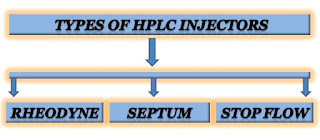HPLC injection is a technique to inject the sample without disturbing the flow rate and pressure of the HPLC system. The working pressure of an HPLC is adequately high that we cannot inject a sample into the mobile phase by inserting a syringe, so we need an injector that gives a reproducible result and without interrupted the flow rate and system pressure. Nowadays HPLC sample injectors are set in a different range of volume so you can inject the specific requires volume.
Here are certain requirements of HPLC Injector are as follows.
- Introduce the Sample with constant pressure and flow rate of the HPLC system
- Introduce the sample without air bubbles
- The injection volumes of the sample are in microliter so it should be accurate
- The sample must be free from any particulate matter
How many types of HPLC injectors are there?
There are three types of injectors are available for HPLC systems such as Rheodyne, septum, and stop flow injector. However, in an advanced HPLC system, an Autosampler is also used to auto-inject the precise volume of the sample.
Rheodyne injector:
The most commonly used injector is Rheodyne which is easy to use with high accuracy and precision. As per requirement, the analyst can set the volume of the sample loop. Rheodyne has two positions load and inject. The load position allows loading the sample into a loop with the help of a syringe which is commonly used to sample load into the injector.
After a load of the sample, manually rotates of the sample injector to the inject position allows flowing the sample onto a column without any air bubbles, without disturbing flow rate and pressure.
Septum injector:
In this system, the sample injects through the rubber septum. The septum is an interface for injecting the sample solution and is used to seal the injection port. It is not commonly used, as the septum must withstand high pressure.
Stop flow injector:
In this type of system mobile phase stopped while the sample is injected. The formation of ghost peaks in the analysis of analyte is the disadvantage of this technique.
Auto-sampler injector:
It is an automatic sample injector that uses to deliver an aliquot of sample to the HPLC column. It is high-tech automation equipment with high precision, variable volume, and long-term reliability. It consists of a valve, a sample dosing, and a moving sampling needle.
Principle of manual injection:
In the load position, using a syringe a sample is filled in a sample loop. The sample loop is shifted to the high-pressure section of the HPLC system when the knob is turned to the inject position. Valves with six ports and two positions for loading and injection are typically used. The most economical way to introduce samples is through manual injection valves.
Several parts are related to the injector of the HPLC system they are injection valve, pulled-loop, pushed-loop, sample container, sampling needle, sample compartment, needle wash port, and pressure transducer.
Commonly asked questions are as follows.
Which syringe is used to inject sample HPLC?
A blunt tip syringe of 22-gauge is used to inject a sample solution into the sample loop. It usually features a stainless steel plunger that is individually fitted to the glass barrel, this allows us to use varied injection volumes.
What is an injection in HPLC?
In chromatography, injection is an important step. The goal is to inject the sample to be analyzed into the HPLC; In general, two injection systems will be available: manual and automatic injection. The volume of the injection loop has a significant impact on the amount of sample injected. Injection loops range in size from 1 to 100 µL.

No comments:
Post a Comment